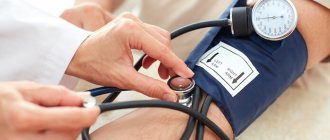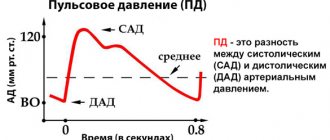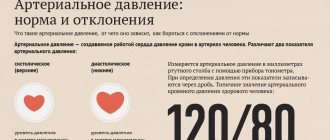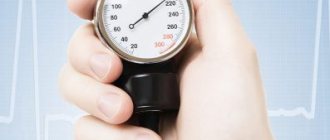What is blood pressure like?
A healthy person is characterized by relatively stable blood pressure readings, but under certain circumstances they can fluctuate, namely stress, nervous breakdown, excessive fluid intake.
Blood pressure indicators characterize systolic (upper) and diastolic (lower) pressure.
Systolic and diastolic blood pressure
The upper arterial is responsible for the intensity with which blood can act on the vessels when releasing the next portion of blood.
The lower one indicates the pressure power at the moment when the heart is resting between contractions.
What pills should I take for high blood pressure?
When medications are prescribed, one drug is used in only 30% of patients. Typically, treatment for hypertension is based on a combination of medications.
The most suitable double combinations for hypertension:
- diuretics + ACE inhibitors;
- ACE inhibitors + calcium channel blockers (CCBs);
- diuretics + β-blockers.
Suitable triple drug combinations for hypertension:
- ACE inhibitors + CCBs + diuretics;
- ACE inhibitors + β-blockers + diuretics;
- CCBs + β-blockers + diuretics.
For persistent hypertension, the most appropriate combination is a combination of ACE inhibitors, β-blockers, α-blockers and calcium channel blockers.
How to measure correctly?
The key to determining the correct diagnosis is to correctly identify blood pressure indicators for treatment. The measurement must be performed with a tonometer, which reflects the most important measurements and pulse rate.
The device is divided into certain types:
- Mechanical - characterized by special rules for applying a cuff, installing a stethoscope and listening to beats (pulse), on the basis of which pressure indicators are determined.
- Semi-automatic - similar to mechanical, the difference is that there is no need to listen to heart sounds and the measurement result is displayed on the screen.
- Automatic - convenient because the measurement result is displayed on the screen; it is quite easy to measure pressure by placing the cuff on your arm at the level of your heart and pressing a button to start measuring blood pressure.
Photos of tonometers:
Mechanical
Semi-automatic
Auto
General recommendations regarding pressure measurements are as follows :
- Measurements should be taken on both hands with a time interval of 5-10 minutes .
- The hand on which measurements are taken must be relaxed .
- Stay in a relaxed state and comfortable position.
- It is necessary to give up alcoholic beverages, smoking and products that contain caffeine an hour before the procedure.
Emergency and preventive measures
If sudden surges and an increase in pressure from 130 to 90 occur at home, what should you do: take a sitting position or lying face down. Place an ice pack on the neck area for half an hour. It’s good if you have an assistant at home who will serve ice and control the time. If there is no effect, then you need to seek emergency help to avoid serious health complications and their consequences.
If an ordinary person has stage I hypertension, then it is not worth treating it with medications yet. It is enough to change your lifestyle to regain normal blood pressure. The best way to do this is:
- Avoid alcohol and nicotine.
- Get rid of excess weight.
- Reduce intake of salty foods and liquids.
- Maintain moderate physical and emotional activity.
What blood pressure is considered normal?
The optimal norm is 120 to 80 mmHg. Art., along with this, the pulse rate is no more than 75 beats per minute.
Classification of blood pressure levels
But if the measurement indicators reach 130 to 85, this is acceptable. The extreme level is considered to be 130-139 at 85-89.
In such cases, treatment is not required; measurements must be taken several times a day, in the morning and in the evening.
Recommended viewing:
Pulse
Normal pulse pressure should be equal to the difference between the upper and lower blood pressure. In our case, it will be: 130-90 = 40 mm. rt. Art. Its decrease may indicate acute heart failure, left ventricular infarction, aortic stenosis, or trauma with large blood loss.
If the tonometer shows too rare or frequent pulse, this is also regarded as a life-threatening condition. If treatment is not done in a timely manner, a stroke or heart attack develops, which in 7 out of 10 cases ends in failure.
An unstable pulse rate most often indicates the following pathologies:
- endocrine abnormalities;
- development of anemia;
- the presence of malignant or benign formations;
- problems in the respiratory system.
Blood pressure 130 over 90 - what does this mean?
The body of a healthy person has indicators in the range from 120, 125 by 80 to 135 by 95 or 139 by 39. This means that results of 130 by 90, 87 are not considered pathology.
If such indications are observed, there is no need to worry about what to do or what treatment to choose. Especially if there is no discomfort.
Factors affecting blood pressure
Problems can be caused by several reasons:
- Exposure to various external stimuli .
- Temperature surges .
- The influence of climate may have a negative impact .
- Drinking caffeine in large doses.
- Age-related changes requiring treatment.
Often during active exercise, blood pressure and heart rate are slightly increased. But if this situation repeats systematically, you need to seek advice from a specialist.
Blood pressure 130/90 – normal or pathological
SBP/DBP = 130/90 is within the normal range and should not cause concern if there is no disturbance in general health. It can grow as a result of physical or mental overexertion, stress, but quickly normalizes after a little rest. Discomfort associated with such indicators, fluctuations in SBP up to 140, auditory and visual disturbances are a reason to visit a doctor.
In this case, blood pressure 130/90 can be regarded as prehypertension, when the state of the myocardium is not yet impaired (SBP), but the blood vessels are already experiencing pathological tension due to changes in structure.
Is blood pressure 130/90 dangerous?
The risk of indicators 130, 134 to 90 is as follows :
- A serious illness of internal organs progresses, especially if this indicator remains high for several days .
- Violation of the healthy functioning of the body.
- For the female half, whose pressure previously was 110-128 per 70-80, and sharply increased to 138 per 90, this leads to a sharp deterioration in the condition.
Useful video:
For hypotension
The danger of high blood pressure
If a hypotensive person is usually characterized by low normal pressure (110-126 per 71-80), then detected high blood pressure with a reading of up to 129-137 per 90 may indicate hypertension that requires treatment.
This condition is dangerous because the walls of the blood vessels are under pressure that exceeds the norm by several times. Loss of elasticity threatens their rupture. The result is that a cerebral hemorrhage may occur, which leads to irreversible consequences.
It is also important to note that an unexpected jump in blood pressure can lead to the destruction of atherosclerotic plaque on the walls of the artery, which in turn clogs the vessel and this is fraught with a stroke or myocardial infarction.
Treatment
Enter your pressure
130
on
90
Search in progress Not found
With a pressure of 130-136 over 90 in both men and women, the doctor recommends the patient change his lifestyle.
At the same time, it is important to follow a daily routine, adhere to a proper diet, avoid stress, regularly exercise and lead an active lifestyle. If pathological processes in the body are detected, drug therapy may be prescribed
If pathological processes in the body are detected, drug therapy may be prescribed.
The following drugs that can lower blood pressure are usually prescribed:
- Neurotransmitters that transmit electrochemical impulses between cells;
- Statins, which reduce the level of bad cholesterol in the blood and have a beneficial effect on the condition of blood vessels;
- Diuretics, or diuretics that help remove excess water and salts from the body;
- Sedative and antihypertensive drugs.
Each medicine is selected individually and depends on the condition and characteristics of the patient’s body.
Treatment is possible not only with the use of tablets, but also with the use of traditional methods to reduce blood pressure.
Expert opinion Guseva Yulia Alexandrova Specialized endocrinologist
Ask a Question
Many of them have positive reviews, but their use should be discussed with your doctor.
High lower pressure - causes
Diseases that cause discomfort:
- Stroke.
- Hypertensive diseases.
- Hormonal imbalances.
- There may be a problem with the pituitary gland.
- Complex processes in the endocrine system.
- Pathologies in the adrenal glands.
Standard tests will help determine the reasons causing this result .
If the source of the problem is a disorder of the urinary system, treatment must be started immediately.
The most common pathologies:
- Congenital malformations.
- Kidney failure.
Signs of hypertension in an adult
Health problems in humans are determined by the characteristics of the body , mainly pressure readings of 130-136 by 90.94 are considered normal.
Also, small deviations should not be taken as pathological. But if the symptoms that appear are accompanied by discomfort , treatment is required.
Possible signs of hypertension
If the following symptoms occur, you should consult a doctor:
- Dizziness and weakness.
- Pain in the head, often in the back of the head.
- Nausea and vomiting.
- Numbness of the tongue or limbs.
- Black dots appear before the eyes.
- Blood from the nose.
- It throws you into sweat, then into chills.
Blood pressure and migraine
I'm worried about pain in the head, and the tonometer shows high blood pressure, which is 130-133 over 90, 92 - what this means will depend on important features .
Blood pressure can be a problem leading to migraines and vasodilation.
Signs:
- Severe pain in the back of the head.
- Nausea and dizziness.
- Severe sensitivity to light.
Headaches and unpleasant symptoms occur in weather-sensitive people. In this case, you need to contact a neurologist and cardiologist.
Increased heart rate
The attending physician will necessarily measure the pulse of a person who complains of high blood pressure. An increase to 80, 88 and 90 beats confirms the initial stage of hypertension. This condition requires constant monitoring by a doctor, including radical lifestyle changes.
Particular attention should be paid to nutrition - reduce salt intake and the amount of liquid you drink.
Patients are advised to monitor their blood pressure and pulse by measuring several times a day.
Indicators of 100-120 are most common, 139 over 93 or 97 is already high blood pressure.
Hypertensive crisis
A sudden, severe condition caused by an excessive increase in blood pressure. This is the problem of hypertensive crisis.
Threatens serious changes in organs and systems:
- Heart.
- Kidneys.
- Brain.
It should be noted that it is quite difficult to name specific numbers that cause a crisis, since a person’s condition depends on the individual characteristics of the body, including blood pressure indicators.
Diagnostic measures
Methods for examining patients with low pulse pressure are standard; in most cases, the problem is detected using routine methods. Patients are managed under the supervision of a cardiologist.
- Survey on complaints, their duration and nature. Necessary for quick objectification of symptoms.
- Anamnesis collection. Including family. Such a small gap between blood pressure values does not allow us to indicate genetic factors.
- Measure blood pressure and pressure levels using simple calculations.
- Daily Holter monitoring using a programmable automatic tonometer.
- Assessment of hormone concentrations in the blood (under the supervision of an endocrinologist).
- General analysis of liquid connective tissue, biochemistry.
- Clinical examination of urine.
- Electrocardiography with stress tests. It is carried out in real time, all indicators are recorded here and now. Caution is required, since complications are likely in patients with latent cardiovascular diseases.
- Echocardiography. Ultrasound technique for identifying problems with muscle organ structures.
- Assessment of neurological and nephrological status (routine methods).
- Ultrasound of the kidneys and excretory system.
- Doppler ultrasound of blood vessels.
- Angiography.
This is quite enough in the system; it is important not to miss the moment for diagnosis. Other methods are also possible, it all depends on the complexity of the situation.
Blood pressure 130 over 90 during pregnancy
Blood pressure can increase noticeably during pregnancy. Therefore, indicators of 130 over 90, 132 over 86 are the norm, but it is worth knowing that the maximum acceptable blood pressure value during pregnancy is 140 (upper) over 90 (lower, cardiac).
Before the examination, a woman needs to be more attentive to her own feelings and write down the results of the tonometer in the morning.
If all measurements are in perfect order, and no discomfort or other problems are observed with an increase, this is the body’s reaction to changes in the amount of hormones .
However, if high blood pressure is observed frequently and symptoms of hypertension are present, then consultation with your doctor is necessary .
Symptoms of hypertension
When prescribing medications, the doctor needs to know :
- Number of weeks of pregnancy.
- age .
- Any impact on the baby.
It is best to use healthy herbs and drink other folk remedies.
Pathological causes
Often, a pressure of 130 over 90 means that the cardiovascular system is not functioning properly.
The volume of fluid in the systemic circulation increases against the background of the development of pathologies that provoke the formation of edema. Destructive changes in one of the parts of the heart and inflammatory damage to arteries, veins, and capillaries are possible. The pathological causes of a persistent rise in pressure are determined during the diagnostic process. What diseases can be detected after a series of instrumental and laboratory studies:
- atherosclerosis - systemic damage to large and medium-sized arteries, which is characterized by the formation of plaques on the walls of blood vessels;
- varicose veins, thrombophlebitis - pathological changes in the veins (usually the lower extremities), the formation of blood clots that have a negative effect on blood circulation;
- glomerulonephritis, pyelonephritis - diseases of autoimmune or infectious origin that disrupt the functioning of the kidneys and the vessels that supply them with blood;
- endocrine disorders (diabetes mellitus, hypothyroidism), occurring against the background of a decrease in the production of hormones necessary for the regulation of all vital systems.
Obesity is also a pathology. When walking, obese people feel short of breath, suffer from rapid heartbeat and increased blood pressure. Excess fat deposits in the subcutaneous tissue cause not only psycho-physical discomfort, but also lead to diseases of the spine and joints, the development of atherosclerosis and hypertension.
Features in women
With the onset of natural menopause, the level of female sex hormones estrogen decreases in the body. A decrease in the level of these bioactive substances negatively affects the condition of blood vessels. Therefore, an increase in blood pressure during menopause to 130/90 is observed quite often. The problem is usually solved by hormone replacement therapy.
A similar condition is observed during the period of bearing a child. During pregnancy, the circulatory network expands to supply the child with necessary substances and oxygen, and constant hormonal fluctuations occur. In the vast majority of cases, after childbirth the condition stabilizes within a few days.
Women are more emotional than men and experience conflict situations or a series of failures more acutely. Therefore, their blood pressure often increases for neurological reasons and is manifested by irritability, causeless anxiety, and apathy.
Features in men
In representatives of the stronger sex, the first signs of unstable functioning of the cardiovascular system usually appear after 40 years. But sometimes young men under 30 develop symptoms of first-degree hypertension. The development of this pathology is determined by a long history of smoking and alcohol abuse of any strength.
Men are more often exposed to serious physical stress due to their professional activities. Many of them are fans of fried, fatty foods, smoked foods, foods high in spices and salt. All these factors negatively affect the condition of the veins and arteries and the functioning of the myocardium.
What to do if you have high blood pressure?
In a situation where it is not possible to measure pressure with a tonometer, you need to pay attention to the accompanying symptoms. In this case, you get a headache and feel dizzy, and you feel a strong loss of strength.
General recommendations
But if there is a device that will show indicators of 127 to 89, 130, 131 to 90, then it is better to adhere to several rules :
- You need to cool the back of your head with an ice compress or a damp towel.
- After completing the procedure, measure again. Take a sitting position, and your hand should be on a flat surface.
If you have a persistent problem of high blood pressure, you should consult a doctor. It is also recommended to forget about smoking, alcoholic beverages, lead a healthy lifestyle and try to avoid stressful situations.
What pills should I take if my blood pressure is 130/90?
reduce blood pressure with the help of certain groups of medications. Even if there are no problems , and the indicators vary between 120, 123 to 70, it is necessary to undergo examination every year . In the future, the pressure may reach 130, 131 over 90, 98.
If necessary, a competent course of treatment will be prescribed, appropriate medications that act normally and safely if diagnosed in a timely manner.
| A drug | Effect |
| Inhibitors | Prevents narrowing of arteries, preventing critical illness. Eliminate the risk of thickening in the heart muscle (especially with problems with upper blood pressure, the indicator of which is 152, 148), requiring treatment. |
| Sartans | Needed to quickly relieve vascular spasms. They act quickly and have few adverse reactions. |
| Beta blockers | They normalize the condition and are suitable for the treatment of cardiovascular diseases. |
| Diuretics | Used for frequent increases in blood pressure. Effectively remove fluid from the body. Gradually reduce vascular swelling. |
| Combined action agents | They constrict blood vessels, relieve problems in the form of spasms, and relieve pain. |
What to do
You should only worry if there is a persistent increase in the lower reading. Here you cannot do without consulting a doctor.
At home
A one-time increase in pressure to 130/90 with an increased pulse of 90-100 beats/minute with deterioration in health can be stopped as follows:
- lie down, calm down, you can wash your face with cold water first;
- open the window;
- lightly massage the back of the neck, earlobes, for 10-15 minutes;
- rub your hands;
- give up all physical activity.
As soon as it feels better, go for a walk.
Tablets used for high diastolic readings
| Group, representatives | How they work |
| ACE inhibitors: Benazepril, Lotensin, Spirapril | Reduce blood pressure, prevent heart attack, stroke, combine well with other drugs |
| Beta blockers: Carvedilol, Labetalol | Reduce the lower value, use with caution in case of kidney pathology |
| Calcium antagonists: Nifedipine, Felodipine, Diltiazem | The effect is similar, used with magnesium |
| Sartans: Telmisartan, Valsartan, Eprosartan | Reduces blood pressure and has a nephroprotective effect |
Diuretics, sedatives, and combination drugs are used on the recommendation of a doctor if necessary. Folk remedies are ineffective and can be used after primary therapy in the form of ready-made diuretic or sedative teas.
BP 130/80 - what to do?
Hypotonic patients in crisis need emergency assistance. At home, a person is recommended to take a comfortable position - half-sitting, lying down. Perform tonometry on one, then the other arm, and assess the condition. If necessary, take half a tablet of Captopril or Nifedipine. If after half an hour the pressure does not decrease, drink another half.
Even a single hypertensive crisis in a hypotensive person is a reason to go to the doctor.
People with normal blood pressure and hypertension, when there are no dangerous symptoms and feel good, can postpone visiting a specialist. To stabilize the situation, non-drug methods are quite suitable.
- It is worth streamlining your work-rest schedule.
- Avoid alcohol and tobacco.
- Walk more.
- Increase the amount of healthy food (vegetables, fruits, lean meat and fish, cereals), give up unhealthy foods (sweet, fried, smoked, salty, pickled).
- Lose weight (if obese).
- Play sports (biking, swimming, running).
- Adequately perceive stressful situations.
Preventive measures are indicated for everyone who has experienced pressure surges more than once.
In addition, it is necessary to learn how to correctly carry out the tonometry procedure.
Causes of high blood pressure
Essential arterial hypertension (hypertension, see medications for high blood pressure) causes persistent increases in pressure and hypertensive crises. Symptomatic hypertension (adrenal tumors, renal vascular diseases) gives a clinical picture similar to hypertension. Vegetative-vascular dystonia is characterized by episodes of blood pressure surges not exceeding 140 to 90, which are accompanied by vegetative symptoms. An isolated increase in lower pressure is inherent in renal pathologies (developmental anomalies, glomerulonephritis, atherosclerosis of the renal vessels or their stenosis). If diastolic pressure exceeds 105 mmHg. for more than two years, the risk of brain accidents increases by 10 times, and a heart attack by five times. Systolic pressure increases more often in older people, people with thyroid pathologies, patients with anemia and heart defects. An increase in pulse pressure is a serious risk of developing a heart attack or stroke.
What is normal and what is pathology
You can often hear about the optimal (normal) blood pressure being 120/80. However, these values only apply to healthy adults. For example, children and diabetics may have serious problems with hypertension. How does a person's blood pressure depend on age? Blood pressure 130/80 – is this normal or not?
In children
Unfortunately, problems with hypertension do not bypass children - up to 50% of obese boys and girls face this problem and serious complications in the future. Therefore, pressure monitoring should not be ignored.
In infants, the optimal ratio is only 80/40. By default, doctors measure blood pressure in children aged 3 years and older at each regular examination, at least every 3 years. As age increases, blood pressure also increases, the ideal values of which depend not only on the age and gender of the child, but also on his height.
Standard values for older children are around 110/70 (readings of 125/75 are often recorded, which are also not considered hypertension). In children, however, “white coat syndrome” is often present, which can manifest itself as an accelerated pulsation (with a pulse of 100 beats!) and high blood pressure in the doctor’s office (even readings of 130 to 75 are found). It is advisable, in case of doubt, to measure it at home, at rest, and repeat the measurement several times.
In adults
In an adult, blood pressure should vary between 120-131 over 75-80. If the readings exceed 140 to 83-90, it is good to be on your guard and consult a doctor - hypertension is dangerous, it should not be underestimated, it can cause heart palpitations, damage blood vessels, and lead to a stroke or heart attack. Values below 100/65 indicate low blood pressure. There is nothing dangerous about this. But low levels that persist over a long period of time can make life unpleasant (a person may experience fainting, frequent headaches, and dizziness).
In sick people
If you have diabetes or any other long-term condition, talk to your doctor about the right blood pressure levels for you. For example, in case of kidney disease, it is considered elevated already at a normal value of 120/80.
Remember! Hypertension is life-threatening and should be monitored by a doctor!
What to do if your blood pressure is 130/80? Currently, every 2nd adult man and every 3-4th adult woman suffer from varying degrees of hypertension. The disorders are more common in older people, but are not uncommon in younger age groups. This condition reflects the lifestyle and, in particular, the care that a person devotes to his health. Genetic factors also play an important role.
Increased performance does not only occur during times of stress or serious psychological problems. Often a person doesn’t even notice a blood pressure of 130 over 80. This is why hypertension is called the silent killer. Changes in eating habits, in particular limiting salt intake and losing excess weight, are effective tools for reducing high blood pressure. Their effect is enhanced by other lifestyle changes (smoking cessation, stress reduction, limiting excessive alcohol consumption, regular physical activity). If the pressure remains 130 over 80 or higher, despite following the above rules, you should consult a doctor and seek advice about possible pharmacological treatment.
Important! Medicines to control hypertension are effective only when used regularly and consistently. . Avoid caffeine consumption, especially coffee, energy drinks, various soft drinks, Mate tea
Classic coffee can be replaced with a decaffeinated drink or chicory. Even when choosing mineral water, be careful - a pressure of 125 to 80 or higher is not compatible with drinks with a high sodium content.
Avoid caffeine consumption, especially coffee, energy drinks, various soft drinks, and Mate tea. Classic coffee can be replaced with a decaffeinated drink or chicory. Even when choosing mineral water, be careful - a pressure of 125 to 80 or higher is not compatible with drinks with a high sodium content.
Enrich your diet with enough fresh vegetables and fruits. On the one hand, these food ingredients are guaranteed to contain no salt, on the other hand, they will provide you with the necessary nutrients that are suitable for weight loss.
Although the list of inappropriate foods seems very extensive, do not despair, over time you will get used to the changed diet, and you will be confident that you have done everything possible to improve your health.
Characteristic symptoms
People with initially normal health when their blood pressure rises often suffer from headaches in the back of the head and temples. In terms of their symptoms, they resemble migraines. Throbbing pain intensifies in bright light, accompanied by attacks of nausea. Sometimes this leads to vomiting. But unlike gastrointestinal disorders with high blood pressure, it does not bring even short-term relief.
What other signs indicate malfunctions in the cardiovascular system:
- visual and auditory disorders - tinnitus, double vision of objects before the eyes, the appearance of colored circles and black dots;
- dizziness, dangerous with the possibility of falling and injury;
- shortness of breath, feeling of lack of air;
- chills, which is accompanied by excessive sweating, cold sweat, blue discoloration of the nasolabial triangle, pale skin;
- tremor of the hands and sometimes legs;
- apathy, weakness, fatigue;
- drowsiness or insomnia;
- tingling in the heart area.
Hypotonic patients especially suffer in this state. They experience almost all the symptoms. It’s also hard for people who constantly live with higher blood pressure and feel fine. In them, a decrease in both systolic and diastolic pressure is manifested by dizziness and impaired coordination of movements.
Medication and alternative treatment
If prevention methods have not helped within six months, then the doctor will prescribe a drug that, in each individual case, will help normalize blood pressure.
Usually, at the initial stage, medications are prescribed only during periods of exacerbation. The condition is normalized by medicine included in the following groups:
- To reduce the provocative effect of concomitant diseases such as diabetes mellitus, coronary heart disease - ACE inhibitors, which prevent thickening of the myocardium (heart muscle) and narrowing of the lumen of blood vessels.
- To quickly relieve vascular spasm, sartans are used, which have minor side effects, such as Micardis and Losartan.
- Normal blood pressure, together with treatment of the heart and blood vessels, will be ensured by beta blockers such as Atenolol.
- When blood pressure increases, diuretics (diuretics) are usually prescribed to reduce swelling of the vascular walls and remove excess fluid from the body.
- Calcium channel blockers such as Diltiazem will help with increased diastolic pressure.
- Combined-action drugs, such as Andipala, are also good, which combine antispasmodic, vasodilator, and analgesic functions.
Alternative help
Folk remedies for lowering diastolic pressure are hawthorn tinctures with rose hips. A general reduction in blood pressure will be provided by tinctures of peony, valerian or motherwort. It is good to make infusions and decoctions from:
- peony flowers (tbsp/1 l). Pour boiling water, wait until it boils again, cool covered, and after straining, pour into a clean container. Drink three times a day before meals (one teaspoon).
- dried motherwort herb (2 tablespoons per 400 ml). Leave for ½ hour in a tightly closed container, strain. Take the infusion warm, one tablespoon three to four times a day.
- valerian roots (tbsp per glass). Pour boiling water over the raw materials in a thermos, leave for 6–8 hours, consume after meals three times a day after meals (one tablespoon).
- herbal mixture (sage + St. John's wort + motherwort - 1: 2: 5 tbsp. crushed dried raw materials). Stir, pour boiling water in the proportion of 2 tbsp. spoons: 2 cups, close the container tightly, leave for ⅓ hour. Take 3 times a day. 50 ml each.
It helps to lower blood pressure by taking (3 times a day) after eating freshly squeezed lingonberry juice, diluted with water (1/1) with the addition of honey.
It is recommended to take warm baths filled with sea salt, as well as massage treatments. However, with tachycardia, it is better to postpone baths and massage.
A tonometer reading of 130/90 can be a lifelong norm, but with pressure surges and poor health it results in dangerous complications. To avoid this, it is necessary to control blood pressure, seek the help of specialists in a timely manner, follow preventive recommendations, and, if necessary, use various types of treatment. This will help you stay in good shape for a long time.
Did you like the article? Save it!
Still have questions? Ask them in the comments! Cardiologist Mariam Harutyunyan will answer them.
Ivan Grekhov
Graduated from the Ural State Medical University with a degree in General Medicine. General practitioner











